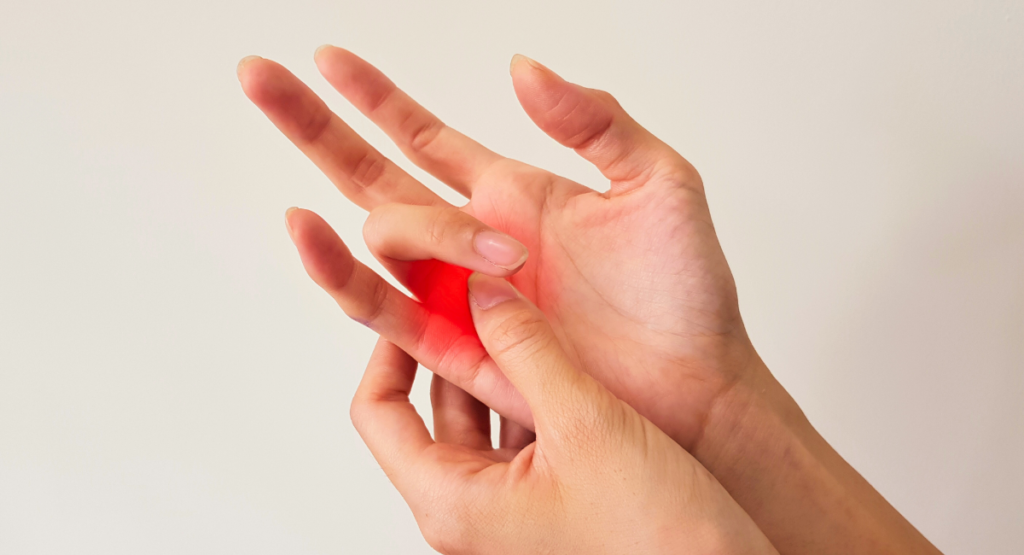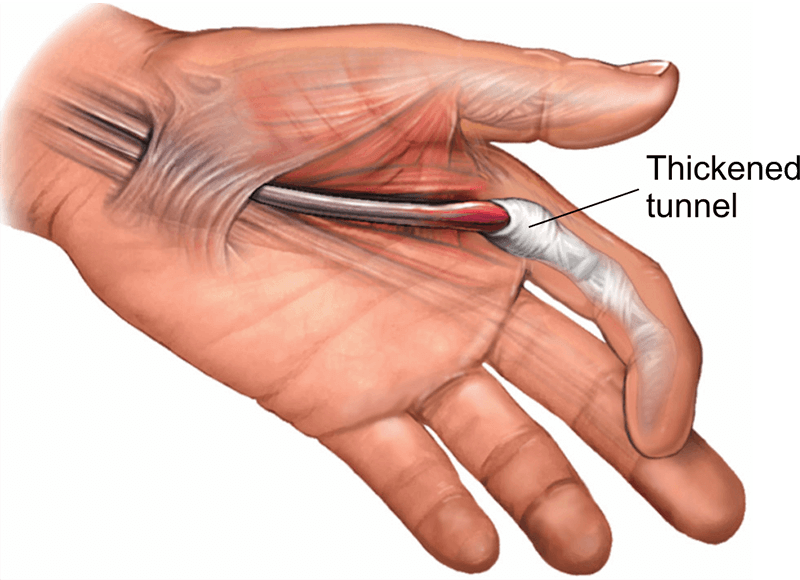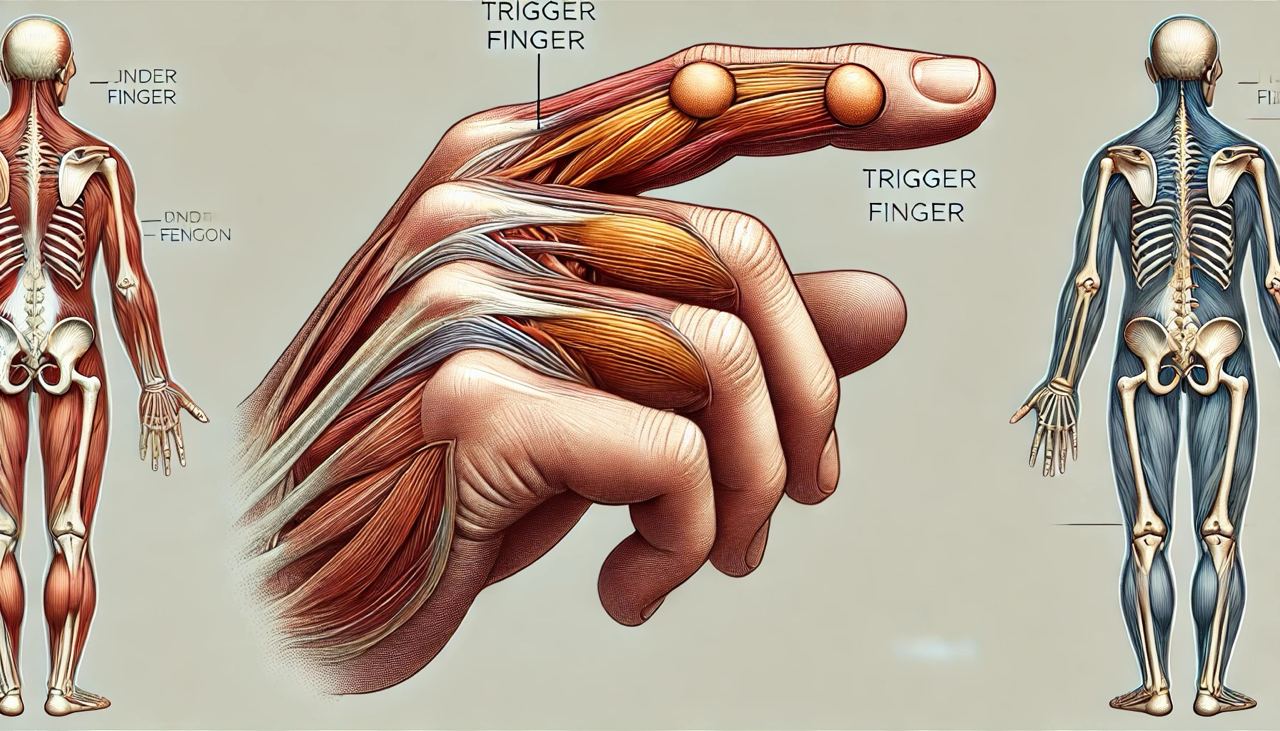Definition of trigger finger
Ngón tay lò xo is, in essence, a condition involving inflammation of the tendon sheath of the flexor tendons of the fingers. Consequently, this inflammation causes the tendon sheath to narrow. In some cases, the inflamed flexor tendons develop nodules, which impede the mobility of the flexor tendon through these nodules.
As a result, each time the finger is flexed or extended, it becomes challenging. Therefore, the patient must either try to pop the finger out or use the uninjured hand to pull the finger out, as if it had a spring. This explains why the disease is referred to as the trigger finger.

Nguyên nhân
- Một số nghề nghiệp có nhiều nguy cơ mắc bệnh: Nông dân, giáo viên, thợ cắt tóc, bác sĩ phẫu thuật, thợ thủ công...
- Chấn thương
- Hậu quả của một số bệnh: Viêm khớp dạng thấp, đái tháo đường, viêm khớp vảy nến, gút, …
Symptom of trigger finger
Triệu chứng của ngón tay lò xo rất dễ nhận biết vì nó mang lại cảm giác đặc biệt khó chịu cho bệnh nhân:
- Flexing one or more fingers may be difficult, and the finger can get stuck in a flexed position, resembling a trigger.
- Đau ngón tay tại vị trí bao gân bị viêm và tại hạt xơ, khó cử động ngón tay.
- You can feel the nodule on the flexor tendon of the finger at the metacarpophalangeal joint. The nodule moves when flexing and extending the finger.
- The finger maybe swollen.

Chẩn đoán
Doctors can diagnose trigger finger based on clinical symptoms. However, they sometimes need paraclinical tests to support differential diagnosis and treatment.
- Ultrasound: ultrasound with a probe frequency of> 7.5-20MHz can see thickened tendons, tendon sheaths, and surrounding fluid. Images of tendon sheath fibrosis can be seen.
- You do not need special blood tests or X-rays. However, you must perform basic tests before administering medication or injecting corticosteroids, particularly blood sugar, and liver and kidney function tests.
Điều trị
Tuy không phải là một bệnh lí nguy hiểm nhưng nếu không được điều trị sớm và quản lí chặt chẽ, ngón tay cò súng có thể gây nên những hậu quả nghiêm trọng như teo cơ gấp ngón tay, xơ cứng gân cơ gấp và mất chức năng cầm nắm của bàn tay.
- Nguyên tắc điều trị:
- Combining various treatment methods can be effective. These methods include no medication, medication, local corticosteroid injections, physical therapy, rehabilitation, or surgery.
- Additionally, actively preventing disease recurrence involves using a gentle and reasonable work and living regimen. This approach should be combined with medication, physical therapy, and rehabilitation to achieve the best results.
- Các phương pháp điều trị không dùng thuốc:
- First, limit movement of the damaged tendon.
- Additionally, physical therapy can include ultrasound therapy, cold compresses if there is swelling or redness, and infrared radiation.
- Moreover, acupressure massage involves pressing and kneading to increase circulation, reduce pain, and help soften stiff and inflamed tendons.
- Furthermore, acupuncture helps by stimulating local tendons, reducing pain, and increasing circulation.
- Các phương pháp điều trị dùng thuốc:
- Các thuốc giảm đau theo bậc: Paracetamol/Codein.
- Các thuốc giảm đau kháng viêm NSAID: Diclofenac, Meloxicam
- Tiêm corticoid tại chỗ (Betamethasone, Methylprednisolone) cần tuân thủ các chỉ định và chống chỉ định.

- Điều trị ngoại khoa: Phẫu thuật giải phóng chèn ép, cắt bỏ phần viêm xơ nếu điều trị nội khoa thất bại.
Phòng ngừa
- First, limit finger use and establish a reasonable rest regimen.
- Additionally, practice hand and finger exercises to support recovery.
- Furthermore, stabilize any chronic diseases, such as obesity, gout, diabetes, or rheumatoid arthritis, if present.

